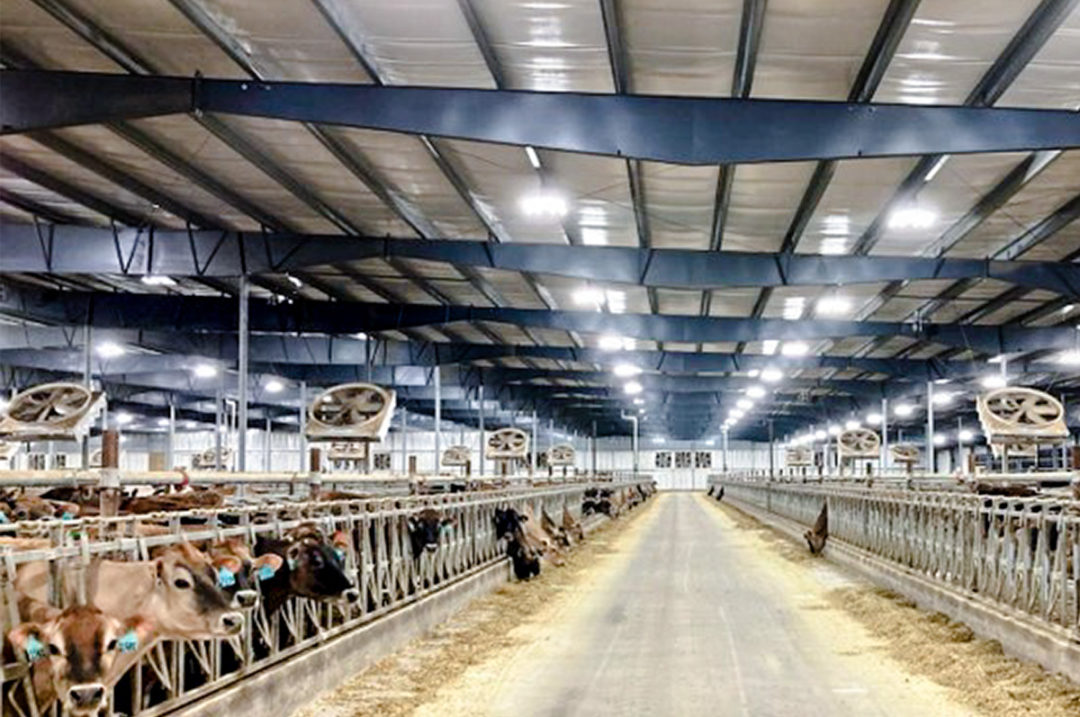Lighting plays a crucial role in dairy production and management, one that is often overlooked. The effect of light in the cow’s day and night cycle is well researched, and there are clear benefits to having consistent long-day lighting throughout the year. Winter is the perfect time to review your lighting protocol and consider upgrading it for a long-day lighting system. Even if you already have a long-day lighting strategy in place, it is also important to review your system’s performance if it has been installed for four or more years. As time goes on, lights lose potency and require maintenance or replacement.
What is long-day lighting?
Long-day lighting focuses on providing constant and evenly distributed light levels for a period of 16 to 18 hours of light and six to eight hours of darkness for lactating cows in the barn. The light period is typically designed for 15 to 20 (160 to 215 Lux) foot-candles, with the dark period having 1 to 4 (10-40 Lux) foot-candles. It is important that the light is distributed as evenly as possible, particularly in the resting area of the cow, and that the period of darkness is managed to be completely uninterrupted. Two great sources for long-day lighting recommendations, design and explanation are from the University of Wisconsin and the University of Minnesota.
Brief history of long-day lighting
There are over 40 years of research on the lighting effects on cows and production, but the main academic reference typically can be found in this article: "Photoperiodic Effects on Dairy Cattle: A Review."
In the article they conclude: “Exposure to long days increases milk production in cattle with little effect on milk composition. Cows eventually increase intake to meet the increased energy demands to support greater milk yield.”
This review is cited by the American Society of Agricultural and Biological Engineers (ASABE) standards and many other university extension and outreach programs that recommend long-day lighting for lactating cows as a good investment and management practice. While this research is still widely accepted because there are known benefits to long-day lighting systems, it is important that long-day lighting is managed properly to reap its benefits.
Benefits of long-day lighting
The most cited number is an increase of 5 pounds of milk per cow by using long-day lighting systems. This is typically paired with an increase in dry matter intake of around 2 pounds per day per cow. However, there are other benefits to consider, such as increased worker safety by having better-lit areas in the barn for longer periods. Aside from benefits to lactating cows, light can also have a large impact on dry cows. We won’t get into that in this article, but you can read more on short-day lighting in this article: Increase early lactation milk production with short-day lighting during the dry period.
Challenges with long-day lighting
Creating a long-day light system can be as simple as turning your lights on and off at certain times. However, ensuring the times are correct and maintaining a consistent light level can be challenging without the proper protocols and equipment. The University of Michigan, in an ASABE presentation paper, described some of the logistical challenges with long-day lighting, citing that Michigan producers were unable to reproduce the expected results from long-day lighting.
To address the technical difficulties Michigan farmers faced implementing long-day lighting systems, this project conducted farm energy audits, collected production data and had dimmable LED fixtures coupled with sensors located throughout the barn to adjust the light output slowly throughout the day. Their two-year trial showed that the long-day lighting system increased production by 7.22% when compared to their based system. The paper also reports that cows appeared calmer, cleaner and less aggressive toward others after living in the newly controlled lighting environment.
While the positive impact of long-day lighting is clear, the paper concludes that “… these positive impacts can only be achieved by implementing a consistent, automated lighting system that controls light output based on real-time light data …” and that the benefits of these systems may have been missed due to outdated or improperly designed systems as well as disruptions due to manual operation. Therefore, a proper long-day lighting strategy with the right products is key!
ROI of long-day lighting
It is challenging to quote specific numbers because everyone’s lighting needs will vary. However, there are some published values claiming that a completely new lighting system with energy-efficient fixtures could break even in one fall/winter season.
As we mentioned before, the increase in milk production is paired with an increase in feed intake. It is important to review the energy cost, feed cost and milk price to determine your strategy.
Depending on the type of lighting, you may also be eligible for a rebate on the system from your utility company. With all this being said, most publications show a positive return on properly managed long-day lighting systems.
Lumen depreciation
Commonly known as the light loss factor, lumen depreciation is a multiplier used to predict the future performance of a lighting system. This is why most future systems will be designed for 20 Lumens instead of 15, to provide a longer lifetime of the system where the light intensity will still be enough to provide long-day lighting. If you decide that a long-day lighting system will benefit your dairy, ask what lumen it is being designed for and when the system is expected to need replacement. Most lighting fixtures will have ratings explaining their lumen depreciation and when it is expected to be replaced.
Long-day lighting pays off
To some it may still sound like magic, but long-day lighting has shown – both in research and real-world settings – that it can provide increased milk production for a lactating herd. It will require an investment and a commitment to manage the system to see its benefits. Thankfully, there are many lighting options with clear ratings, automated technology and experts that can help design and maintain your system.
References omitted but are available upon request by sending an email to the editor.










